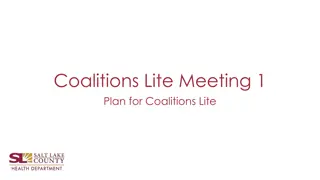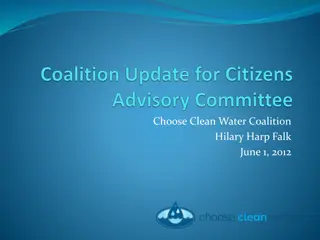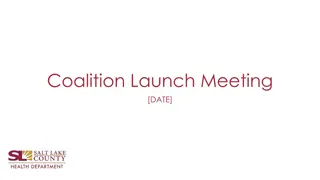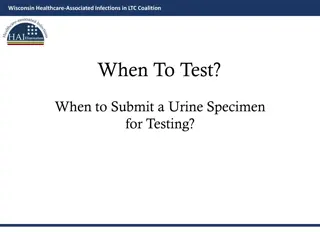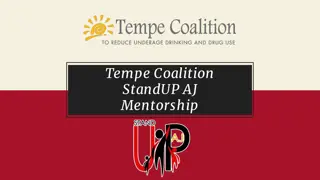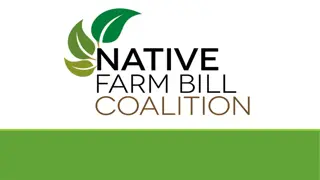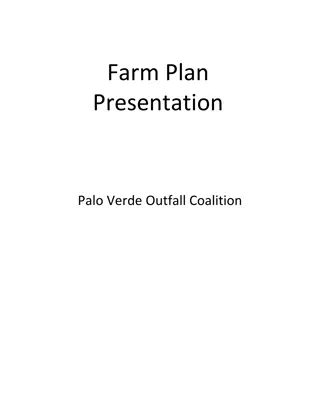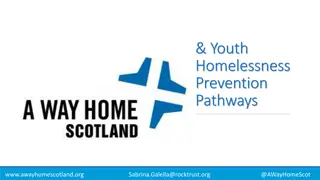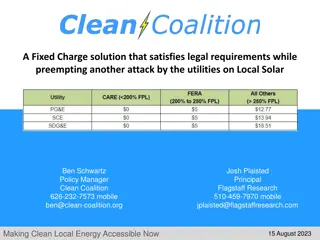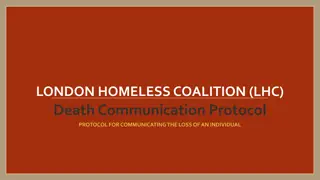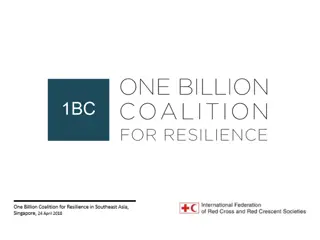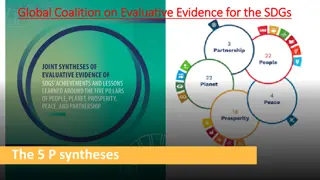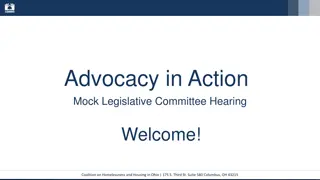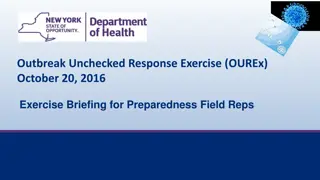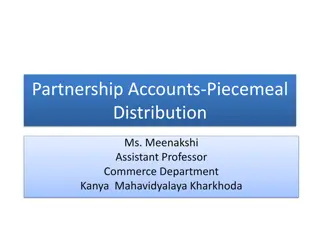Capital Area Healthy Start Coalition Needs Assessment Presentation
The Capital Area Healthy Start Coalition, established as part of the Florida Healthy Start Initiative, is conducting a needs assessment to identify issues affecting maternal and child health outcomes in the community. The assessment aims to determine high-risk populations and prioritize groups for intervention based on socioeconomic and medical factors. The coalition's goal is to develop a data-driven 5-year service delivery plan to reduce infant mortality and low birth weight babies. A dedicated team of professionals is leading this comprehensive effort.
Download Presentation

Please find below an Image/Link to download the presentation.
The content on the website is provided AS IS for your information and personal use only. It may not be sold, licensed, or shared on other websites without obtaining consent from the author. Download presentation by click this link. If you encounter any issues during the download, it is possible that the publisher has removed the file from their server.
E N D
Presentation Transcript
Capital Area Healthy Start Coalition Presentation of Needs Assessment Monday, November 16, 2020
Florida Healthy Start Initiative Created by Governor Lawton Chiles in 1991 Established Healthy Start Coalitions Public/private partnerships in each Florida community to provide for a system of care that would reduce infant mortality and low birth weight babies System of care is based on recognition that biological, environmental, economic, social and psychosocial factors influence pregnancy and child health outcomes
Capital Area Healthy Start Coalition (CAHSC) Capital Area Healthy Start Coalition direct services and activities Coordinated Intake and Referral (Connect Program) Healthy Start Home Visiting Program Capital Area Fetal and Infant Mortality Review Community Initiatives CAHSC is charged with developing a 5-year Service Delivery Plan to provide a system of care to reduce infant mortality and low birth weight babies This Service Delivery Plan will utilize a comprehensive assessment of maternal and child indicators. As well as risk factors and needs in the community, to guide its services and activities
Goals of Needs Assessment To assess the biological, social, psychosocial, economic and environmental issues of our community, as well as identify the prevalence of our poor pregnancy outcomes, high-risk populations, economic costs and trends, from which to determine the priority groups who are at high risk of poor pregnancy outcomes due to socioeconomic/medial factors. To provide the foundation for the direction and development of an effective data-driven and evidenced- based 5-year service delivery plan to be complete during this next year.
Needs Assessment Team Kyra Adams Jackie Hanners Courtney Atkins Torhonda Lee, PhD Kacey Brown Jalaycia Lewis Dr. Joedrecka Brown Speights Unam Mansoor Claudia Blackburn Miaisha Mitchell Fran Close, PhD Pam Pilkinton Sandy Glazer RoseAnn Scheck Megan Deichen Hanson, PhD Christal Szorcsik Jessica De Leon, PhD Arianna Waddell Debra Dowds Marcus West Samantha Goldfarb, DrPh, MPH Mary Westbrook Betsy Wood
Methodology Secondary Quantitative Data Primary Qualitative Data Analysis of Data
Secondary Quantitative Data Florida Charts Healthy Start Prenatal and Infant Screens and Screening Results CAHSC FIMR Project Reports Vital Statistics Annual Reports U.S. Census Bureau State and County Quick Facts Robert Wood Johnson Foundation-County Health Rankings and Road Maps Tallahassee Memorial HealthCare Needs Assessment - September 2009 Leon County/City of Tallahassee Community Human Services Partnership Needs Assessment - November 2019 Children s Services County Steering Committee Recommendations -December 2019 Department of Health Leon County Community Health Assessment - September 2019 Department of Health Wakulla County Community Health Assessment - 2017
Primary Qualitative Data Focus groups planned for Spring 2020 cancelled due to COVID-19 Individual interviews with Healthy Start participants Interviews of Healthy Start Care Coordinators and professional community partners Interviews with key stakeholders
Analysis Analysis of primary and secondary data Comparison of data of top needs from 2010 Service Delivery Plan with current data Identification of Priority Needs
General Characteristics of Coalition Area Population increasing slightly over the past 5 years Leon County 285,233 in 2015; 296,717 in 2019 Wakulla County 31,323 in 2015; 32,418 in 2019 Women of Childbearing Age (WCA) also increased Leon County 75,968 in 2015; 77,997 in 2019 Wakulla County 5,195 in 2015; 5,394 in 2019
Women of Childbearing Age-by Race WCA by Race, Leon 2019 WCA by Race, Wakulla 2019 4.1% 10.0% 7.0% White White Black Black 36.6% 56.4% Other Other 85.9%
Women of Childbearing Age-by Ethnicity WCA by Ethnicity, Leon 2019 WCA by Ethnicity, Wakulla 2019 5% 8.1% Hispanic Hispanic Non-Hispanic Non-Hispanic 91.9% 95%
Poverty The number of individuals below the federal poverty level in Leon County has consistently been above the State whereas the number of individuals in Wakulla County has been below that of the State.
Unemployment The unemployed civilian labor force in Leon County was below the State until 2014, when it rose above the State rate The Wakulla County unemployment rate has remained below the State rate throughout this time period
Education ADULTS WITH NO HIGH SCHOOL DIPLOMA BY YEAR Leon Wakulla Florida 20.4 19.7 19 15.8 15.6 15.1 14.7 14.5 14.2 13.9 13.6 13.5 13.1 13.1 12.8 12.5 12.5 12.4 12.3 12.3 12.1 12 11.1 8.8 8.3 7.9 7.7 7.4 6.8 6.4 2009 2010 2011 2012 2013 2014 2015 2016 2017 2018 The percentage of adults 25 years+ without a high school diploma has remained fairly stable at 12-15% statewide over the past 10 years Leon County s rate of less than a high school education has decreased over the past five years to a low of 6.4% in 2018. Wakulla County s rate more closely mirrors the statewide average at 11-15%.
Housing 22% of households in Leon County had at least 1 of 4 housing problems (overcrowding, high housing costs, lack of kitchen facilities, lack of plumbing facilities) 12% of Wakulla County households were inadequate 20% of households in the state had at least one of these housing problems
Transportation 6.4% of Leon County households did not have a car 3.1% of Wakulla County households did not have a car Statewide percentage = 6.5%
Improve Pre-pregnancy Health: Overweight Mothers at time Pregnancy Occurred
Improve Pre-pregnancy Health: Obese Mothers at time Pregnancy Occurred
Improve Pre-pregnancy Health: Smoking During Pregnancy
Improve Maternal and Child Health System of Care
Qualitative Methods Individual interviews HS clients in Leon and Wakulla Counties (N = 14) Key community stakeholders (N = 3) Questions for both clients and stakeholders: What are the challenges/barriers to having a healthy baby? What can be done to make it better/easier to have a healthy baby? What would you say are the priority areas / areas of the greatest need for pregnant women and newborns? Stakeholder interviews also included COVID-19 questions: What has been the impact of COVID-19 on pregnant women and infants in the community? What are the most pressing needs for pregnant women and new mothers in regard to COVID-19? What is needed to meet these needs? What do you think the future impact on this population will be? What will be needed to help women and infants going forward?
What can be done to make it easier to have a healthy baby? PROGRAMS AND SERVICES Supportive care, services and programs that are: Women and family friendly Culturally competent Developed with community engaged approaches to truly meet community s needs Fluid and flexible for tailored implementation Evidence based Targeted to communities with the worst maternal and infant outcomes Accessible/at more convenient locations
What can be done to make it easier to have a healthy baby? PROGRAMS AND SERVICES More education and outreach needed about programs and services Home visiting programs Desired program structure and components Match personnel with client s lived experience to facilitate shared understanding of clients' background and culture Provide mentors for pregnant women, especially for first time mothers Have more one-on-one/very small group interaction and training Include food access and nutrition and cooking education Greater access to healthy food and cooking techniques
What can be done to make it easier to have a healthy baby? PROGRAMS AND SERVICES Educational programs that are: For both mothers and fathers Designed and delivered to help parents deal with the quantity of information they are trying to absorb Education for youth on: Employment and the working world Sex education - in schools and with parental involvement Anti-violence - bullying, domestic violence, sexual violence Education for parents on: Importance of prenatal care Parenting skills
Health and Healthcare Challenges and Barriers Access to care Complexity of navigating the healthcare system Further complicated for at risk, vulnerable, underserved, etc. Economic and financial constraints Costly and frequent copays at the end of pregnancy Long wait times for services Transportation and childcare barriers Limited healthcare options for rural residents Mental Health / Substance Abuse Chronic stress over the lifespan Need for more services and increased access to care and services Physical Health General health at all times - before, during and after pregnancy Inadequate nutrition
Challenges and Barriers Environmental Problems with the built environment, e.g., lack of sidewalks, poor lighting Unsafe neighborhoods Sociocultural Female burden as mothers, familial caretakers, employment Cultural barriers Programs/healthcare/providers not culturally competent Racism, discrimination and mistreatment Racism causes chronic stress over the lifespan that impacts physical and mental health Structural racism impacts the social determinants of health
Challenges and Barriers Socioeconomic Poverty Insurance status Structural Systems of care and services exist, but people are still falling through the cracks Residents do not feel heard, feel disenfranchised
COVID-19 COVID-19 is a health disparity multiplier that exacerbates existent disparities Housing Crowded living conditions Higher representation in service work with increased risk of exposure, jobs with limited or no benefits, no paid sick leave Data collection methods, educational outreach not culturally competent Racism and discrimination
COVID-19: Health and Healthcare Challenges Still many unknowns about COVID-19 and its long-term impacts Concerns about impact of the virus on mothers and babies Diversity and varied severity of symptoms makes this disease complex Questions regarding reinfection, immunity and vaccines Effects on children Service and access barriers Reduced services Overtaxed services Reduced service hours
COVID-19: Pregnancy and Birth Challenges Pregnancy and prenatal care Avoidance of health care settings and medical appointments due to fear of exposure to virus COVID-19 fears for pregnant women: Am I at risk? Is my baby at risk? Labor and delivery Postpartum women are going home earlier after delivery Women are having to change birth plans Can only have one visitor during delivery Reduced familial participation and support
COVID-19: Pregnancy and Birth Challenges Breastfeeding mothers Is breastfeeding safe? What are risks versus benefits? What public health measures should be taken (e.g., wearing a mask)? COVID-19 positive mothers What are the implications for mother s health? babies health? Other family members and caregivers?
COVID-19 Mental Health Impacts and Challenges Added stress at an already stressful time Stressors from COVID-19 include: Children out of schools/challenges of distance learning Childcare access barriers Employment impacts (job loss, reduced wages, business closures, unemployment benefit barriers) Economic/financial strain Impacts and fears around physical health and healthcare Household/family relations Access barriers Mental health telehealth services available to new patients only after an initial face-to-face appointment Scheduling delays may leave women without care during the short post-partum time period
Identified Priority Needs: Primary Data Findings Nutrition/Access to food Overall health of the community High rate of smoking Wakulla County Affordable housing Maternal mental health needs Affordable childcare Poverty Lack of resources Access to medical care Transportation Lack of jobs/Unemployment Increased use of marijuana while pregnant Coronavirus
Identified Priority Needs: Secondary Data Findings Infant mortality rates higher than the state rate High racial disparities in birth outcomes Women being unhealthy and having chronic illnesses before and during pregnancies Obesity Poverty Health inequity Data Source: Florida Department of Health, Bureau of Vital Statistics
Key Priority Areas Racial disparity is evident in birth outcomes and infant mortality in our two counties Opportunities for culturally responsive and wholistic approaches to improving maternal and child Addressing provider and system-level bias Access to community resources, medical care and mental health services prior to, during, and after pregnancy have been identified as an unmet need in our service area Increasing access to health insurance Availability of providers
Next Steps Completion and Submission of Needs Assessment Needs Assessment Slide Presentation will be posted on the Coalition s website Draft Needs Assessment Report will be posted on the Coalition s website Public comments, including questions and your recommended key areas of focus for the 5-year Service Delivery Plan, welcomed from November 17th through November 30th Needs Assessment Report finalized and submitted to DOH by December 31st Capital Area Healthy Start Coalition Website: capitalareahealthystart.org
Next Steps Development of 5-Year Service Delivery Plan 5-Year Service Delivery Plan will provide a blueprint for the collaborative work of the maternal and child health community to address the key issues and findings influencing perinatal and child health outcomes identified in this Needs Assessment Plan is due to Department of Health by June 30, 2021 Plan development process will begin in January 2021 Your participation is important for - Developing objectives and strategies Partnering to implement objectives and strategies


